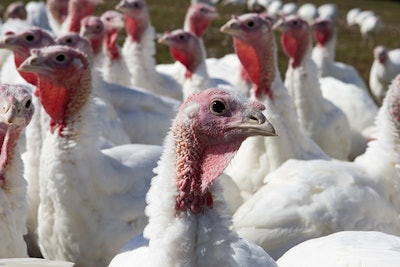
The worst may be over for now, but COVID-19 is shaping the present and future of the domestic turkey industry.
In March 2020, the pandemic arrived in the United States and sent much of the country into a lockdown for weeks or months. As of early August 2020, the disease’s impact on the country is still profound with many hallmarks of public life either closed or limited and the economy still sputtering.
With the turkey market entering its critical fourth quarter, industry associations and economic observers say there will be enough turkey to go around for the Thanksgiving season and winter holidays, but the consumer will likely be paying a higher price.
The initial shock
National Turkey Federation (NTF) President Joel Brandenberger said the months since the outbreak have challenged the industry and the supply chain. However, the turkey industry – like the broiler industry – benefitted from swift action by regulatory bodies to keep the supply chain moving and is following the guidelines set forth by the U.S. Centers for Disease Control and the U.S. Department of Labor’s Occupational Safety and Health Administration.

Joel Brandenberger, National Turkey Federation (Courtesy National Turkey Federation)
Nevertheless, the industry felt the impact of the virus in terms of both infections and closures and was forced to cut back production to accommodate lower demand.
Hormel Foods Corp.’s Jennie-O Turkey Store closed three plants temporarily between April and May 2020 after workers tested positive for the disease and concerns about community transmission ran high. Cargill Protein also temporarily closed a plant due to similar concerns in April 2020.
Butterball LLC reportedly ended a number of grower contracts in Missouri in April 2020. In May 2020, West Liberty Foods LLC, citing a lack of demand and excess of birds, announced plans to suspend poult placements for 18 weeks starting in June 2020 and furlough about 300 workers from November 2020 through February 2021.
The present situation
The disease remains present in the U.S. and shows few signs of slowing down, which means the industry will continue to deal with the COVID-19 challenge until a vaccine is developed or a successful treatment is identified. Armed with experience and guidance, the industry is better prepared to react now to outbreaks and market challenges, Brandenberger said.
As of July 2020, every turkey plant should be operating albeit with stricter sanitation and new social distancing and worker health protection measures in place, Brandenberger said. The experience varies from company to company and plant to plant, however, as some plants run at reduced capacity due to lower than normal demand and workers continue to face anxiety surrounding the disease.
Dr. Thomas Elam, president of FarmEcon LLC and an industry consultant, projects that overall turkey production is dropping significantly due to sharp reductions in poult placements since April 2020. He said the U.S. Department of Agriculture expects production to drop by about 200 million pounds in 2020, but he expects it be between 300 million and 400 million pounds in 2020.

Dr. Thomas Elam, president FarmEcon LLC (Courtesy Thomas Elam)
That said, the worst of the COVID-19 impact should be over now that production of birds is shifting downward to meet lower demand. Elam said the biggest impact was the “total disappearance” of foodservice demand and elevated retail demand in the early weeks of pandemic. Starting in May 2020, foodservice demand began to increase slightly, but he said its likely to be a slow return to normalcy on that front.
The impact for the grower and the integrator
Turkey growers themselves should be facing a somewhat negligible impact, Elam said, due to the contracts most growers work on. There will be some who are negatively affected if the company they work with decides to skip a flock and their overall volume and income decline.
Brandenberger said the NTF will continue to campaign for federal relief for turkey growers affected by the pandemic as Congress continues to work on public aid packages focused on COVID-19.
As for the integrators, Elam predicts most will be operating at the break even point or at a loss in 2020. The two publicly-traded companies – Butterball, the largest turkey company in the U.S. according to WATT Global Media’s Top Poultry Company rankings, and Jennie-O, the second largest – disclosed their results in recent earnings reports.
Butterball, according to a release dated July 28, 2020, reported a net loss of $27 million during the second quarter of its fiscal 2020. Its part owner, Seaboard Corp., went on to say it does not expect its turkey segment to be profitable for the rest of the year. It attributed the poor performance to a “lower volume of turkey products sold, a decline in foodservice demand and higher production costs primarily related to labor.”
Elam said Butterball is not alone in paying higher costs related to labor. Many turkey companies will be spending significantly more on disease mitigation efforts such as increased personal protective equipment, new personnel barriers and even hiring new staff strictly to control virus transmission.
Jennie-O, on the other hand, is profitable, according to its latest earnings report. On May 21, 2020, Hormel reported the turkey business made a quarterly profit of $27.4 million due to the strength of its retail, whole bird and commodity sales, which offset its decline in foodservice demand.
Looking ahead
Elam said the worst is likely over for the turkey industry, and the outlook is much better than it was at the onset of the COVID-19 pandemic largely due to the production cuts made in the spring and summer. Integrators should benefit from favorable feed prices, too.
As for the consumers buying whole turkeys for Thanksgiving and winter gatherings, both Elam and Brandenberger agree there should be enough to go around. However, Elam said the consumer will likely pay a higher price for that bird than they are used to paying and the retailers will likely not be offering aggressive specials to entice shoppers to purchase more.

There should be enough turkeys for Thanksgiving, but consumers will likely pay a higher price than usual. (Bhofack2 | Dreamstime.com)
As for 2021, Elam said much of the picture will be determined by COVID-19 and how much longer it keeps affecting American society. Until restaurants, institutions and travel and leisure businesses return to full occupancy, it could be a long, slow slog for the turkey industry.

















